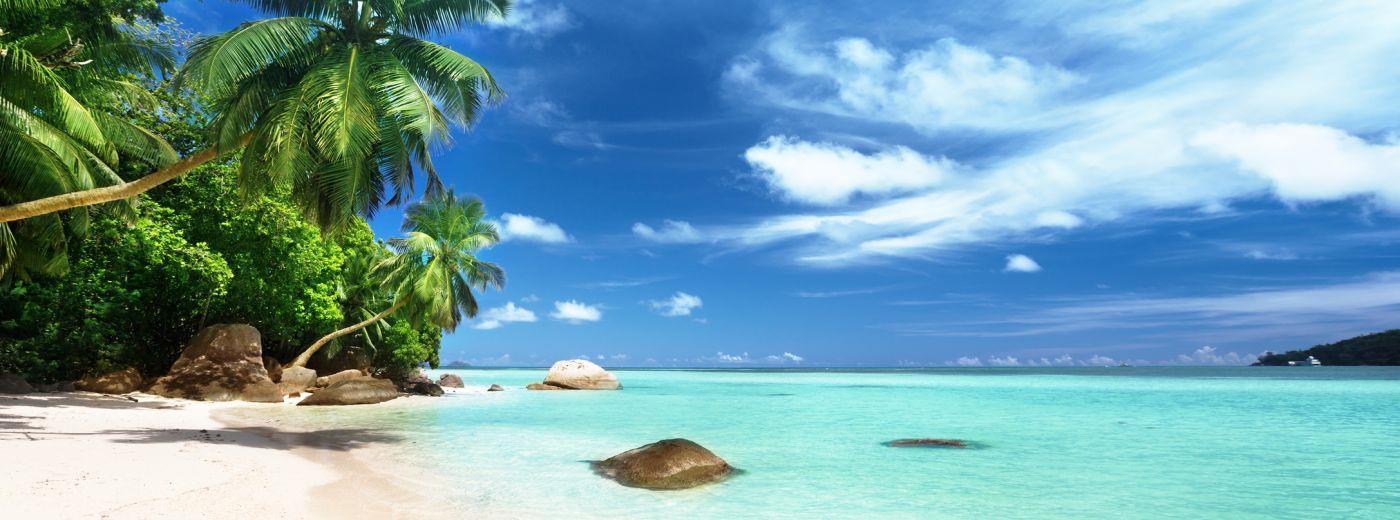Best Time To Go, How To Get There, Combining Beaches With An African Safari
Finding the best beach option to combine with your safari can seem very daunting given the transport arrangements involved and the fact that the weather at different times of year can vary so much in each region.
We hope that this guide to Africa's best beach destinations will help you find the ideal beach for your own safari and beach holiday, and if you would like to discuss some of the options or start planning your own trip then simply get in touch via the live chat or the enquiry form, or give one of our friendly experts a call on 01483 266725.
Mauritius & Seychelles
For many people, Mauritius and Seychelles represent the perfect Indian Ocean beach extension to their African safari experience, and with their tropical climate, white beaches and warm waters it is easy to see why they are so popular.
Getting to either Mauritius or Seychelles does take a little bit of planning as both are set way out in the Indian Ocean away from the African mainland and are reached by fairly long direct flights from the main hub airports of Southern and East Africa. For example:
Nairobi to Mauritius: 4 hours 15 minutes
Nairobi to Seychelles: 3 hours 15 minutes
Johannesburg to Mauritius: 4 hours 30 minutes
Johannesburg to Seychelles: 4 hours 55 minutes
A: Seychelles B: Mauritius
Please note that not all routes have daily departures, and depending on your itinerary you may need to overnight near Johannesburg or Nairobi to catch an early flight the following morning.
In addition to flights linking them to the African mainland, there are direct flights to the UK and other European destinations, as well as flights via hub airports in Dubai and Abu Dhabi connecting to the rest of the world. This means that it is possible to fly into somewhere in Southern or East Africa for your safari, then fly over to Mauritius or Seychelles to enjoy the beach before flying back home without having to go via the African mainland.
The island of Mauritius has a landmass approximately 4.5 times larger the total of all the 115 islands of Seychelles combined, and the population of Mauritius is about 1.3 million people compared to less than 100,000 people in Seychelles. The fact that Seychelles has a small population that is dispersed over so many islands means that the costs of transport and all imported goods is much higher here than in Mauritius, and this is also reflected in accommodation prices, making Seychelles the more expensive of the two countries to visit. It is also fair to say that there are only a handful of hotels in Seychelles that offer All Inclusive rates, whereas this rate structure is more widely available in Mauritius.
In common with tropical and sub-tropical islands across the world, Mauritius and the islands of Seychelles have average temperatures that do not change much during the year (especially Seychelles) and they are liable to see rain, often in the form of spectacular late afternoon storms, throughout the year.
For Seychelles, the wettest months are December to February, and June, July and August are the driest. The southeast trade winds blow regularly from May to November, and this is the most pleasant time of the year to visit.
In Mauritius the summers rains are a little less intense, however they stretch from December through toward the end of March or early April. May to November are the driest months in Mauritius.
Mauritius Average Max and Min Temperature
Mauritius Average Rainfall (mm)
Seychelles (Mahe) Average Max and Min Temperature
Seychelles (Mahe) Average Rainfall (mm)
Kenya Coast and Zanzibar
A: Kenyan Coast B: Zanzibar
The Kenyan Coast and island of Zanzibar (just off the Tanzanian coast) are part of East Africa's Swahili Coast, and they share common culture as result of their history on the trade routes that linked Arabia and Africa long before the first Europeans arrived in the area.
Both of these areas are easily accessible and can be combined with all of the various safari options in East Africa including the Masai Mara, Amboseli, the Serengeti, Ngorongoro Crater and the gorillas of Rwanda and Uganda. There are even a couple of direct flights a week linking Johannesburg and Zanzibar for people doing a safari in Southern Africa, although generally speaking the connections between Southern Africa and the East African coast require connections through Nairobi.
Most visitors to Kenya's coast stay in the hotels around Diani beach, and on Zanzibar visitors have the choice of staying in bustling, historic Stone Town or one of the many beautiful beach hotels around the island. Some visitors to Zanzibar will choose to stay a couple of nights in Stone Town and the rest on the beach as this gives you the opportunity to have dinner on a rooftop terrace in the town as the sun sets and the calls to prayer echo over the rooftops. Of course, it is also possible to spend the whole of your stay on Zanzibar at a beach hotel and then do day trips to see Stone Town or visit a spice farm should you decide to take a break from the coast.
The coastal areas of Kenya around Mombasa and the island of Zanzibar have similar climates to one another. Both have a hot and dry start to the year before the intense rains arrive from March to May. The average temperatures fall a little after the rains and then slowly build over August to October in the build up to the second rainy period which is centered around November.
Kenya Coast Average Max and Min Temperature
Kenya Coast Average Rainfall (mm)
Zanzibar Average Max and Min Temperature
Zanzibar Average Rainfall (mm)
The Mozambique Coast And Islands
A: Quirimbas B: BazarutoC: Maputo
Mozambique's coastline and Indian Ocean islands offer unspoilt beaches and protected reefs and are perfect for scuba diving or snorkelling.
Just 30 km off the coast of the mainland from Vilanculos, the Bazaruto Archipelago is one of the most beautiful places on the African continent, complete with azure waters, sandy beaches, palm trees and pristine coral reefs with tropical fish. There are a handful of beautiful lodges spread over the 4 main islands, and this really does feel like a remote tropical paradise, although all the lodges are quite expensive as everything has to be flown over from the mainland.
Quirimbas Archipelago is a chain of 32 islands that stretch for 250 km along the northern Mozambican coastline, and which are accessed from the town of Pemba on the mainland. Again, the fact that everything needs to be flown over from the mainland means that prices here are quite high.
There are daily flights from Johannesburg to Vilanculos and Pemba, and from these points you can transfer over to the lodges on the Bazaruto Archipelago or Quirimbas Archipelago, making Mozambique an easy beach destination to get to after a safari anywhere in Southern Africa. For people doing their safari in the Southern Kruger Park or one of the nearby reserves such as the Sabi Sands, there are 6 flights a week from Nelspruit Kruger Mpumalanga Airport to Vilanculos.
The Maputo area has warm and wet summers with the highest rainfall in January and February, although it should be noted that these months are still far drier than the wettest months further north in Kenya, Zanzibar, Mauritius or Seychelles. The winters that run from May to September are a few degrees cooler than the summer, and rain become far less frequent, making this a favourite time for many visitors.
Vilanculos and Bazaruto have a similar weather pattern to Maputo although the summer rains start in December rather than January.
The temperatures in Pemba and Quirimbas vary less than those further south, with average highs around 29°C to 32°C year around. In the June to August winter months average lows are still very mild at around 19°C. This part of the coast does get a little more rain than Vilanculos or Maputo, and the rains here start in December and run through to April. There is usually very little rain from May to November.
Maputo Average Max and Min Temperature
Maputo Average Rainfall (mm)
Vilanculos / Bazaruto Average Max and Min Temperature
Vilanculos / Bazaruto Average Rainfall (mm)
Pemba / Quirimbas Average Max and Min Temperature
Pemba / Quirimbas Average Rainfall (mm)
South Africa's Coastline
South Africa has a beautiful coastline that stretches from Cape Town near the southern tip of Africa to the far north of KwaZulu-Natal near the Mozambique border.
Generally the areas near Cape Town have a more Mediterranean climate with hot, dry summers from November to March and cooler, wetter winters from May to August. As you go further up the coast this changes, until you reach the far north of KwaZulu-Natal where the weather is much more similar to the weather in Maputo than it is to the weather in Cape Town.
You can read more about the climate of South Africa's coastal regions and how these might fit with safaris in different parts of Southern Africa in our guide to the best time to visit South Africa.
Namibia's Coastline
Namibia's coast is sandwiched between the cold South Atlantic Ocean and the barren Namib desert which is one of the driest places on earth. It is spectacular in it's own way, however it is not really suitable as a beach destination in the traditional sense.
You can read more about Namibia's climate in our guide to the best time to visit Namibia.


